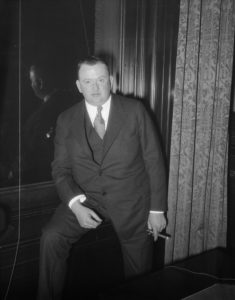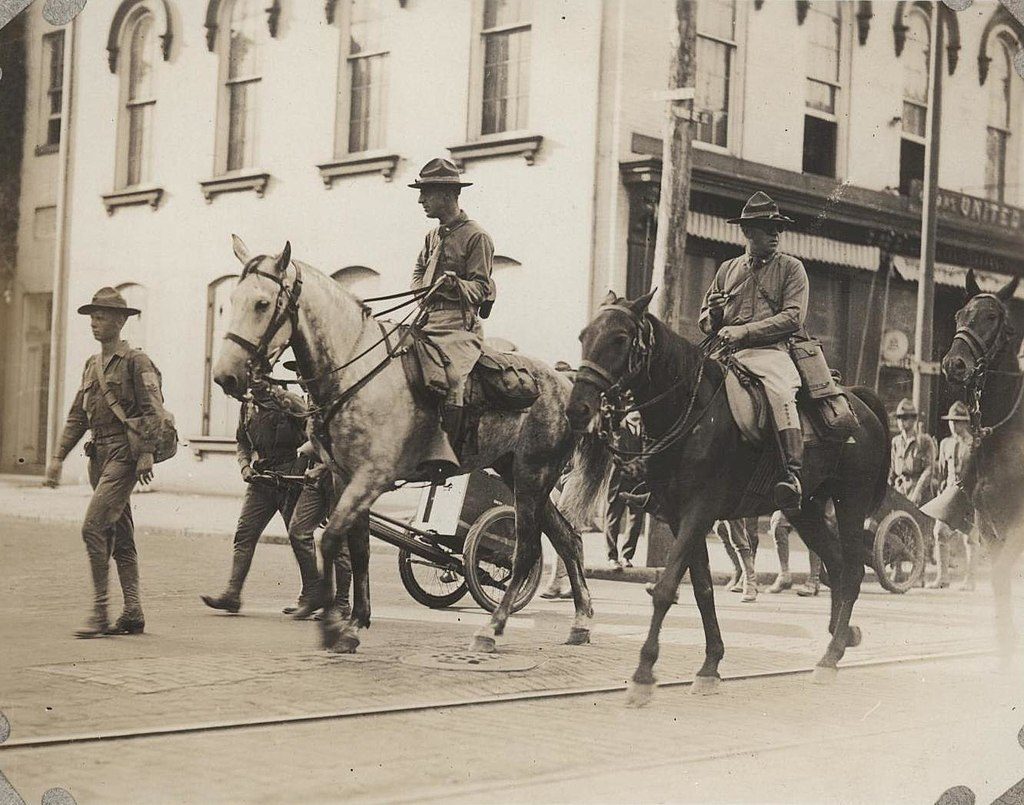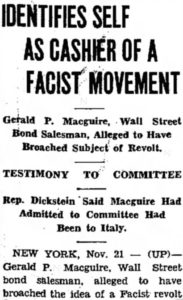By Andy Piascik
In 1933, retired Marine Corps General Smedley Butler was visited at his Pennsylvania home by individuals from the American Legion to discuss upcoming Legion elections. Butler was one of the best-known military men in the country at the time. According to Butler, the visitors came with ulterior motives and chose to meet with him because of his reputation for being popular with everyday soldiers.
Gerald MacGuire

Gerald P. MacGuire, three-quarter length portrait – Library of Congress, Prints and Photographs Division
Among the visitors was Gerald MacGuire, the Legion’s Connecticut commander. MacGuire was born in Rhode Island on May 10, 1897, served in the First World War, settled in Darien, and worked at a prominent Wall Street brokerage house. He and many of the moneyed men he worked with felt alarm at the proposed policies of Franklin Roosevelt, the country’s new president. According to testimony Butler later gave to Congress, MacGuire said he had large sums of money at his disposal to bankroll a run by Butler for the Legion’s top post.
A short time later, MacGuire traveled to Italy and Germany to study how veterans’ groups helped the fascists come to power there. When he returned, he met with Butler several more times and, according to Butler, stated that very wealthy, powerful men had 50 million dollars available to spend on a coup against Roosevelt. The American Legion would be the 500,000-strong vehicle to bring about the coup and they wanted Butler to lead it.
Besides MacGuire, Butler stated that he met with Robert Clark, an heir to the Singer Sewing Machine Company. According to Butler, Clark confirmed everything MacGuire had said and named other plotters, some of whom were among the most prominent and best-known industrialists, politicians, and military figures in the country.
Clark reportedly told Butler that some of those who supported the plan and were willing to bankroll it were executives from the DuPont Corporation (including Irenee du Pont); the Democratic Party’s candidates for President in 1924 and 1928, John Davis and Al Smith; several people associated with the J. P. Morgan banking interests (including Thomas Lamont, great-grandfather of Connecticut governor Ned Lamont); and Grayson Murphy, a director of Goodyear Tire, Anaconda Copper, and Bethlehem Steel. Weapons and ammunition would be supplied by the Bridgeport-based Remington Arms company, or Remington UMC, which had recently been taken over by the DuPont Corporation.
Butler told the story of what became known as the Business Plot to Paul Comly French, a reporter for the Philadelphia Record. When contacted by French, MacGuire spoke openly about the plot and of his desire for a fascist America. He steered the reporter to some of his associates and French wrote an expose that appeared in both the Record and the New York Post. Butler, meanwhile, finally told MacGuire his true feelings about the plan: “If you get 500,000 soldiers advocating anything smelling of Fascism, I am going to get 500,000 more and lick the hell out of you, and we will have a real war right at home.”
Congressional Hearings
Butler reported the meetings to various government officials which led to Congressional hearings in 1934. All of those who Butler named as being involved denied the charge, including MacGuire. In part, because of a lack of concrete evidence, no charges were brought. President Roosevelt intervened to essentially suppress transcripts of the most damning testimony, apparently out of concern over the public outrage that likely would ensue. That testimony was not made public until journalist John Spivak unearthed and published it in 1967.
MacGuire died suddenly and, according to some reports, mysteriously, in Connecticut of pneumonia on March 25, 1935, shortly after the hearings. Catapulted to national fame, Butler became even more famous when he wrote War is a Racket a short time later. In the book, he said of his years as a military man: “I spent most of my time as a high class muscle man for Big Business … a gangster for capitalism” who “might have given Al Capone a few hints.” He died in 1940.
The story of the “Business Plot” has been the subject of documentaries, television programs, and a BBC Radio documentary that implicated another prominent Connecticut man: Prescott Bush, a Wall Street executive living in Greenwich. Bush later became a US Senator and both his son and grandson became president of the United States. Academy Award-winning director Oliver Stone announced in 2000 that he was planning to make a film about the Business Plot but he eventually scrapped the idea.
Bridgeport native Andy Piascik is an award-winning author who has written for numerous publications and websites over the last four decades and is the author of several books. He can be reached at andypiascik@yahoo.com










